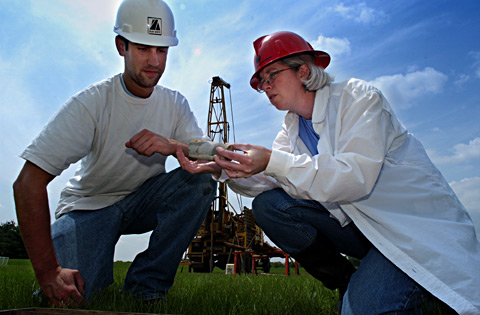Mary J.S. Roth, associate professor of civil and environmental engineering at Lafayette, has received a $76,749 grant from the National Science Foundation for research on improving methods of investigating sites located in sinkhole areas.
Roth, a 1983 Lafayette graduate, will begin research this fall at Lafayette’s Metzgar Fields with two Lafayette students, including Adam Faroni ‘04, a mechanical engineering major from Granby, Conn.; John Nyquist, associate professor of geology at Temple University; and two Temple students, Roth has conducted sinkhole research through NSF grants with several Lafayette students at the same location.
Sinkholes are formed when water dissolves porous bedrock, creating a void into which materials above collapse. Sinkholes in areas with soluble bedrock such as limestone and dolomite cause construction cost overruns and structural failures, notes Roth. The frequency of these problems can be reduced by improving methods for locating subsurface voids that cause sinkholes.
“These areas can be found in 15 percent of the United States, and estimated costs of failures caused by sinkholes in eastern central Pennsylvania since 1975 exceed $30 million,” she says.
Methods she will be using to locate the subsurface voids that cause sinkholes include two-dimensional and three-dimensional earth-resistivity testing, which use electric current to provide information about soil and rock materials below the ground surface. Because it is affected by features near the test area, two-dimensional testing has limited capability to determine void size and orientation, notes Roth, while three-dimensional testing is time-consuming and generally does not reveal sufficient detail. She seeks to overcome these limitations by comparing information from both methods to develop a two-dimensional approach that provides data which a longer, more extensive three-dimensional test would reveal.
Through a Fulbright Grant, Roth pursued research last year in multi-electrode earth resistivity testing in Oslo, Norway, with the Norwegian Geotechnical Institute, one of world’s most prominent research institutes in her field.
“There are other methods of finding out what is below the ground surface which are quite expensive and involve disturbing the ground,” she says. “These methods involve making a lot of borings or probes. Earth resistivity gives more information and it is particularly useful in clay soils, which are common around here and in Norway.”
Roth chose Erin O’Brien of Carlisle, Pa., a Marquis Scholar who graduated from Lafayette last month with degrees in civil engineering and International Studies, to conduct unfinished business from the Norway trip. Through funding from the National Science Foundation, O’Brien spent Jan. 19-25 in Oslo to exchange information about how the United States and Norway conduct environmental site assessments.
Roth was named Engineer of the Year for 2000 by the Lehigh Valley chapter of the Pennsylvania Society of Professional Engineers and 1999 Engineer of the Year by the Lehigh Valley section of the American Society of Civil Engineers. She received Lafayette’s Marquis Distinguished Teaching Award this year, and in 1999, she earned Lafayette’s James P. Crawford Award for excellence in teaching. The award honors James P. Crawford, who has taught in the department of mathematics since 1957.
In addition, Roth was one of a small number of women engineering faculty to be selected to attend the inaugural “Women in Engineering Leadership Conference,” sponsored by NSF, in Winter Park, Colo.
Roth has reached the top of her field after returning in 1991 to teach and conduct research at the college where she received her undergraduate engineering education. Her work as a geotechnical engineer also involves designing foundations, dams, and tunnels. She has provided private consulting services for a number of years, including work in dam rehabilitation.
Roth has been published in the proceedings of the International Sinkhole Conference, the American Society of Civil Engineers’ Geo-institute Conference, the First International Conference on Geospatial Information in Agriculture and Forestry, and numerous peer-reviewed academic publications, including upcoming articles in ASTM Geotechnical Testing Journal and Engineering Geology. She is co-editor of Uncertainty in the Geologic Environment: From Theory to Practice, published by ASCE.
Since February, Roth has made presentations at the American Society of Engineering Education Annual Meeting, the Northeast Regional Meeting of the Society of Women Engineers, and the Symposium on the Application of Geophysics to Environmental and Engineering Problems.
Roth has been a member of the Geo-Institute Risk Assessment and Management Committee since 1992 and the Geo-Institute Geophysics Committee since 2000. She served on the Geo-Institute Retaining Structures Committee from 1991-1998 and on the Technical Editorial Board of Geo-Institute’s Geo-Strata from 1999-2001. She was a member of the organizing committee for the American Society of Civil Engineers Geotechnical Engineering Division Specialty Conference, “Uncertainty in the Geologic Environment: From Theory to Practice,” in 1996.
Roth is a reviewer for the ASCE Journal of Geotechnical and Geoenvironmental Engineering and Journal of Infrastructure Systems, as well as Journal of Hazardous Materials and Engineering Geology. She has been a panel member for review of National Science Foundation research proposals and Environmental Protection Agency fellowship applications.
Roth has taught courses in geotechnical engineering, foundation engineering, environmental site assessment, statics, engineering professionalism and ethics, surveying and engineering measurements, and risk assessment. She earned a master’s of science degree from Cornell University and a Ph.D. from University of Maine. In her free time, she enjoys spinning, weaving, and playing hammered and mountain dulcimers.

Adam Faroni ’04 did EXCEL research that may help prevent the disastrous effects of collapsing sinkholes with Mary J. Spry Roth ’83, professor and head of civil and environmental engineering.
